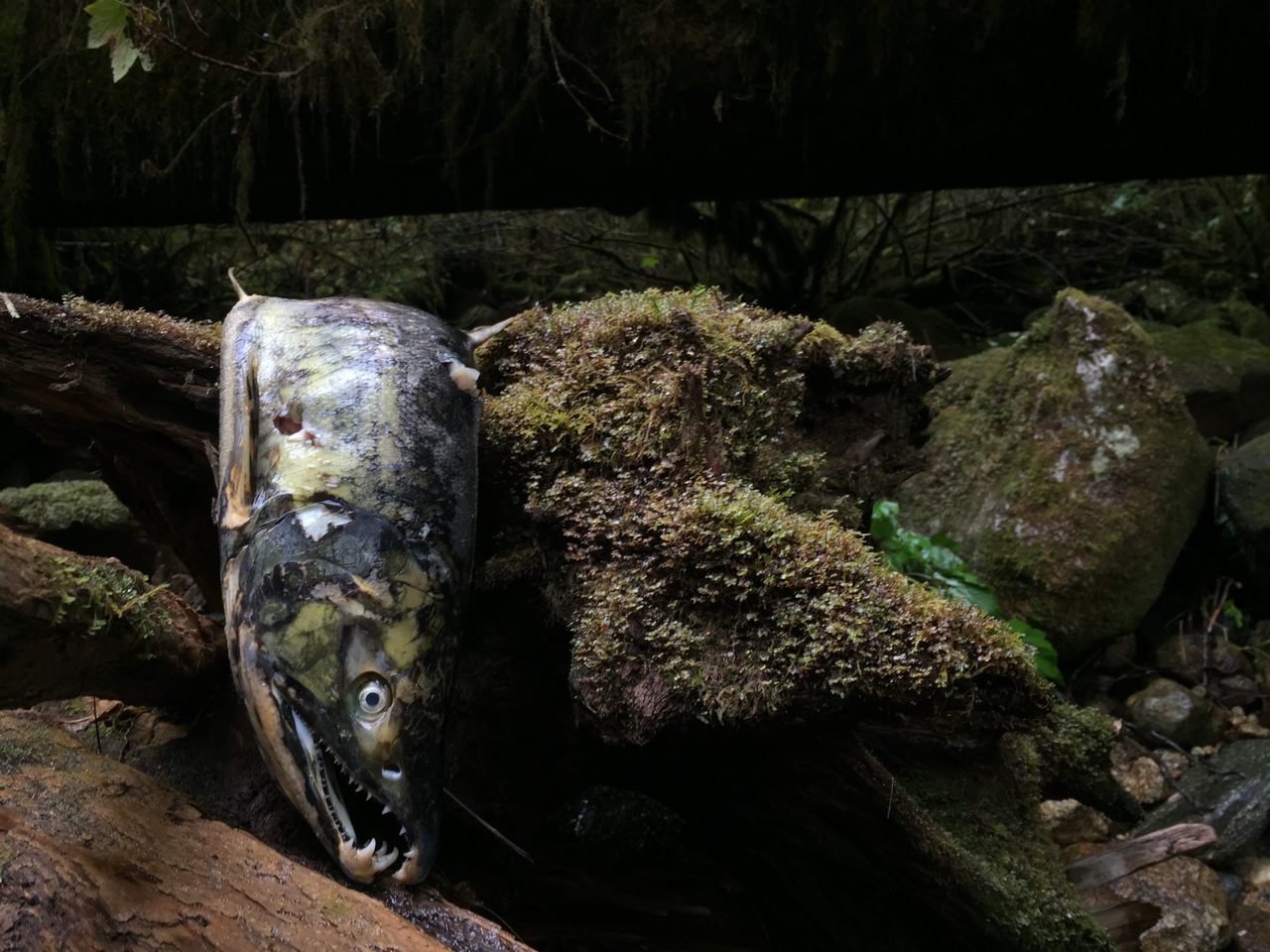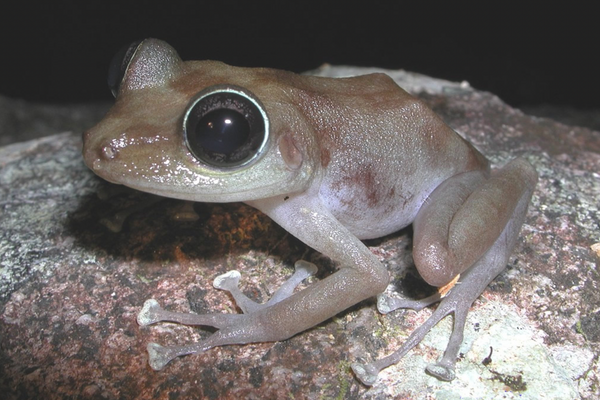In British Columbia, Dead Salmon Make for Happy Butterflies and Bees
Researchers hauled bins of fish carcasses through bear country to learn how salmon affects plants and pollinators.
On a fall day in 2018, Nicola Rammell got into the rhythm of reading dead fish for clues as to what killed them. Wearing waders and white latex gloves, she walked along the skinny streams feeding into a river on British Columbia’s Central Coast with a gaff hook in hand, scanning thousands of pink salmon carcasses for what was missing and what was still there. Wolves left behind headless, finless fish. Holes where dorsal humps had been were the work of bears. No eyes? “Probably the eagles,” says Rammell, who was a research assistant and field technician on a team of biologists from Simon Fraser University at the time. “It was amazing to see all these different signs that could tell us the history of what that salmon had gone through.”
Rammell was searching for whole carcasses among the partially eaten fish. Many pink salmon, also called humpback salmon, end up dead but intact on stream banks as part of a natural cycle of post-spawning mortality known as semelparity: After spending their adult lives at sea, Pacific salmon return to the streams where they were born and throw all their remaining energy into a one-time, self-sacrificial reproductive event. Rammell would nab each carcass with her gaff hook and then drop it into a big plastic bin that quickly filled with dozens of smelly dead fish.

The stream banks Rammell walked were just one stop on the research team’s trek through a wilderness full of rough terrain, hungry bears, and that ever-present stink of rotting fish. The researchers’ destination: a saltmarsh wildflower meadow along the river. Each year from 2016 to 2018, led by Allison Dennert, now a salmon ecologist for the Raincoast Conservation Foundation, the team collected and carted salmon carcasses through the temperate rainforest to that meadow, where they put the fish in mesh bags, staked them to the ground in experimental treatment plots, and watched what grew.

Dennert’s team observed that the salmon-derived nutrients acted as a boon to plant and animal life across the meadow. In response to nutrients from the dead fish, wildflowers like Douglas aster and yarrow popped up in higher numbers, and more pollinators, including bumblebees and hoverflies, visited the blooms. This multiyear experiment makes Dennert the first to demonstrate how nutrients from pink salmon affect plants and pollinators in the foggy, fjord-spliced forests of the Central Coast. To run the experiment, however, her team had to get to the flower meadow in one piece.

To do that, the researchers relied on Howard Humchitt, who was then a research technician and field crew lead at Simon Fraser University. Humchitt, who is Haíɫzaqv (Heiltsuk), guided the team by boat, by kayak, and on foot through the area, which is part of the First Nation’s territory. In return, their research helped scientifically validate the ecological importance of Pacific salmon for Humchitt’s people—something they have experienced for themselves on the Central Coast for millennia. “The research these folks do is very valuable for them, but it’s also valuable for us,” Humchitt says.
On the Central Coast, the river system isn’t quite like the iconic salmon rivers of Alaska’s Bristol Bay. If you were to compare the two systems to blood vessels, Dennert says, Alaska’s wide, open rivers would be like aortas, whereas the narrow, ambling streams of the British Columbian region would be more like tiny capillaries. The surrounding forest can close in on you; hiking into its dense undergrowth demands crawling on one’s hands and knees through sword ferns, salal, false azalea, and stink currant.

“It’s a wonderful place to work, until it’s not,” says research partner John Reynolds, a conservation biologist at Simon Fraser University. “The weather catches you by surprise. Somebody could fall off a log or bump into a bear. It’s one of these places where you could be lulled into a sense of security because you’re taking in the sensory overload of being in these beautiful, moss-covered forests. But you’re a long way from help.”
As the scientists carried the carcasses through this setting, they learned what happens when you’re around rotting fish for too long: The strong odor of ammonia works its way into your hair and clothes and takes about three showers to scrub out, Dennert says. They also learned how to live with their stinking, heavy cargo, making stops to dry heave and towing the fish-filled bins upriver by rope when they could. They often worked in the pouring rain. Once, Dennert bent over a bucket of fish as it hit a boat deck and got a faceful of “liquid slime of death,” she says.

Now and then, they’d hear a howl or a grunt. This swath of wilderness is home to plenty of wolves and bears, and the team’s fall fieldwork overlapped with peak bear feeding season. It didn’t help that the researchers were moving through the area smelling like leftovers. “There’s only a fine line between an amazing story and a tragic ending” with bears, Humchitt says.
Humchitt spent more than a decade guiding scientists safely through Haíɫzaqv territory. After joining the Haíɫzaqv Guardian Watchmen in 2022, he became part of an active group of stewards protecting the land and sea where their ancestors have lived for millennia. These days, he works on Dungeness crab surveys and fishery patrols, but in his time guiding Dennert’s team, he saw himself as their “overwatch,” he says. On hikes through the rainforest, Humchitt taught Dennert to walk through thickets with the backs of her hands facing out to keep from grabbing a handful of the needle-sharp stems of Devil’s club, a native shrub. And he always made sure groups announced themselves around blind corners of the forest with a calm “Hey, Bear!”

Fortunately, although the scientists had the animal’s favorite food with them, bears tend to prefer much fresher fish, Dennert says. Still, it’s important to stay out of their way. “I tell them, this is the bear’s restaurant,” Humchitt says. “We’re in the restaurant, but we’re not on the menu.”
One bear did get curious. During Dennert’s first season of fieldwork on the Central Coast, she and Humchitt were one half of a team that had split up to survey salmon on two different streams about five miles apart. While they were aboard their work boat, a call came in on the radio from the other group. The call was breaking up, but they could make out a few words: “bear…close…moving…toward.” Humchitt showed Dennert how to put the boat in overdrive.
Fortunately, no one was hurt by the time they arrived. As the group piled into the boat, Humchitt asked them where the bear was, now that the animal had given them a wide berth. “Well, who wants to go see a bear?” he asked. “We went up as far as we could, and we spent the next two hours observing the bear in the estuary, fishing, playing—just a bear doing bear things.”
Dennert’s team visited the meadow regularly for three summers to see how flowers and pollinators responded to the bump in nutrients from the salmon left there in the fall. Rammell, now a master’s student studying tundra plant ecology at the University of British Columbia, soaked up the sea of color as she counted flowers and watched insects come and go—something Humchitt encourages. “Stop, and put down the lab coat and the tools,” he says. “Take a minute and look at the territory and what it really is. It’s alive, it’s moving, it has flow.”
Seeing more flowers and pollinators wouldn’t be surprising to the Haíɫzaqv people, Dennert says. They’ve used salmon carcasses to fertilize their gardens for millennia. Her research only reinforces Haíɫzaqv understanding of salmon’s ecological importance. “We now have a database of things that were not really looked at with the salmon,” Humchitt says of Dennert’s project. “We need the salmon, but we also need the bees, the birds, and the plants. It’s all tied together.”


























Follow us on Twitter to get the latest on the world's hidden wonders.
Like us on Facebook to get the latest on the world's hidden wonders.
Follow us on Twitter Like us on Facebook